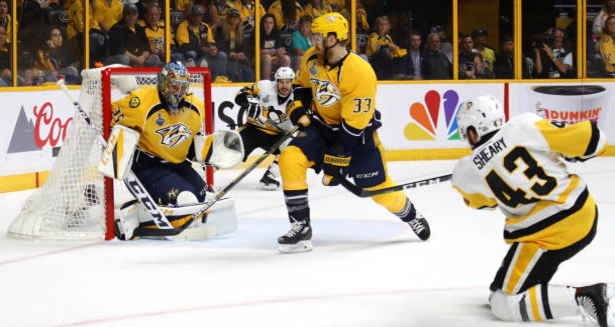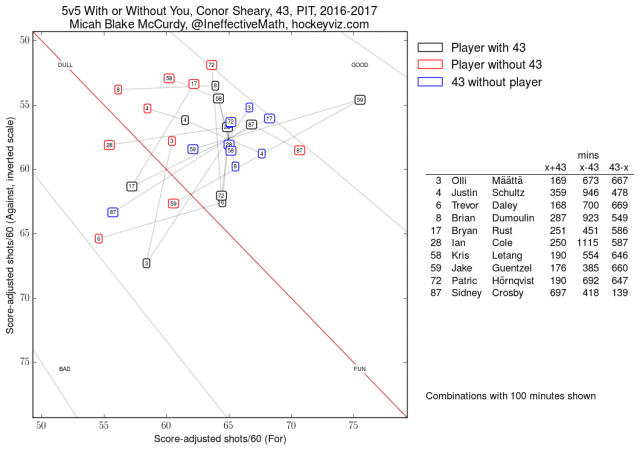With an arbitration date scheduled for this Friday, August 4, the local men’s professional ice hockey club and left wing Conor Sheary avoided the unpredictable proceedings as duly noted by Pensblog’s Peep, when they inked him to a three-year, $9-million contract extension Sunday afternoon that could keep him in Pittsburgh through the 2019-2020 season. The first $1-million of his contract is a signing bonus payable this coming season plus $2-million base salary, while the remaining two seasons will be equal stipends of $3-million each per CapFriendly.
The 25-year old Massachusetts native is player #25 this summer eligible for arbitration who signed a contract either before a hearing, or in the 48 hour post-hearing window before the arbitrator issued a decision. Four players (none from the Penguins) still have scheduled hearings this week.
https://twitter.com/FriedgeHNIC/status/891694249070211073
When I read the news, first reported by Hockey Night In Canada, that Sheary signed for three years at a cap hit of $3-million, my gut reaction was, “too many years,” based on unproven durability and his significantly lower possession numbers playing without Sidney Crosby. However, in hockey as in life, one must abide by the ancient maxim, “Gut is for food; brain is for thinking.”
Let’s analyze and compare Sheary’s statistics and contract in the same fashion that we analyzed his fellow arbitration-avoiding teammate Brian Dumoulin.
CONOR SHEARY, LW
2017-18 AGE: 25
2017-18 to 2019-2020 SALARY: $3-million cap hit ($9-million / 3 year contract)
2016-17 SALARY: $667,500 cap hit + $257,500 performance bonuses; ($1.335-million / 2 year contract)
RELEVANT STATISTICS
After being called up from the AHL shortly before Christmas 2015, Sheary played 44 non-descript rookie regular season games scoring 7 goals and 10 points. In the playoffs, he started turning heads when he scored the same number of points in roughly half the number of games, leading all rookie left wings in playoff points per game. His fourth goal of the postseason was his most memorable one when he converted a set play – likely drawn up by Crosby before the faceoff – for the OT winner in Game 2 of the Stanley Cup Final against San Jose.
[youtube https://www.youtube.com/watch?v=T47OtSOCzyM]This season, Sheary started on a line with Crosby and Patric Hornqvist. His production increased greatly when Hornqvist was replaced with Bryan Rust and at the half-way point of the season, Sheary had scored 17 goals and 35 points in 42 games. An upper-body injury shelved Sheary for all of February but when he returned, lining up with Crosby and rookie Jake Guentzel, he finished strong, tallying 18 points in 19 games. Among all NHL left wings, Sheary was ninth in goals per game and third, behind only Brad Marchand and Jamie Benn, in points per game.
Sheary’s points per game number last season? 0.87… Hey, nothing wrong with being like Crosby in every way possible…
The 2017 playoffs was where many think Sheary was “exposed”, that is, shown to be a much less effective or productive player when he was not skating shotgun with Crosby.
The chart shows that Sheary played an equal number of games in which he skated a majority of his ice time with Crosby and without Crosby. The big difference is in the number of games in which the Penguins posted a positive (or neutral) even-strength shot attempts percentage (SAT% >/= 50) when Sheary skated mostly with Crosby versus Sheary skating on a non-Crosby line. With Crosby: 7-4 in favor of positive SAT%. Without Crosby: 4-7 in favor of negative SAT%. Additionally, even with this small sample size, Sheary’s goals and points also correlate with whether or not he was a linemate of #87. Indeed, Crosby assisted on both of Sheary’s goals in the playoffs.
Furthermore, this with-or-without-you chart (click it to enlarge) from hockeyviz.com shows clearly how much Crosby helped drive Sheary’s play this past season. These charts aren’t meant to be a shot at Sheary. Facts are facts. Nonetheless, the bottom line is that Sheary is making the most of his golden opportunity to skate alongside Crosby. Think of Erik Christensen and others who couldn’t cash in on the ice and at the pay window while on Crosby’s line. Notably, while Sheary’s raw SAT% dropped from 57.5% in his rookie campaign to 52.5% in 2016-17, his relative SAT% increased from 2.8 to 4.0. Those are strong numbers from a sophomore forward.
COMPARABLE PLAYERS
Here are some left wings from the past five seasons who, like Sheary, reached RFA status after two full seasons in the NHL then signed a contract extension.
| Player | Tm | Age | GP | G | A | PTS | S% | TOI |
|---|---|---|---|---|---|---|---|---|
| Chris Kreider | NYR | 22 | 66 | 17 | 20 | 37 | 12.5 | 1038 |
| Ondrej Palat | TBL | 22 | 81 | 23 | 36 | 59 | 13.9 | 1461 |
| Jaden Schwartz | STL | 21 | 80 | 25 | 31 | 56 | 13.3 | 1402 |
| Conor Sheary | PIT | 24 | 61 | 23 | 30 | 53 | 14.9 | 972 |
| Player | Tm | GP | G | A | PTS | S% | TOI |
|---|---|---|---|---|---|---|---|
| Chris Kreider | NYR | 89 | 19 | 21 | 40 | 12.3 | 1271 |
| Ondrej Palat | TBL | 95 | 25 | 38 | 63 | 13.8 | 1625 |
| Jaden Schwartz | STL | 132 | 34 | 38 | 72 | 13.9 | 2045 |
| Conor Sheary | PIT | 105 | 30 | 33 | 63 | 14.6 | 1401 |
Although Kreider’s production was clearly a step below Sheary, Palat and Schwartz at that stage in their careers, I added Kreider because his playoff performance at the time with the Rangers was excellent. He had just come off a 13 point postseason, good for fourth-best on his Eastern Conference championship club, bringing his career totals to 11 goals, 22 points in 41 games (versus 6 goals, 17 points in 45 games for Sheary).
EVALUATION OF SALARY IN RELATION TO COMPARABLE PLAYERS
It’s very interesting that after two full seasons in the NHL, Sheary and Palat, who earned an even richer contract earlier this summer for his continued success, both produced very similar results on the scoresheet. Consequently, one could reasonably value Sheary in the same echelon as the Tampa Bay left wing. Taking into account an 8 to 9% rise in the salary cap since these three comparable players signed their first RFA contracts, I would have tendered Sheary a $7.25-million, two-year contract for an average annual value of $3.62-million.
IMPLICATIONS ON PENGUINS SALARY STRUCTURE
In reality, Penguins GM Jim Rutherford was able to net the undersized forward for a 17% lower cap hit than the above model valuation while making a three-year commitment. After starting off not being a fan of this deal for its length, I realize part of its actual strength is that it buys out one year of unrestricted free agency. Sheary would have been eligible to be a UFA and hit the open market after the 2019 playoffs on a theoretical two-year contract. Like with the recently-inked Dumoulin, Rutherford is bullish on Sheary decreasing games missed due to injury, becoming more durable as he adapts to the hitting and overall physical toll of an 82-game schedule plus playoffs, and therefore is not shy about granting a longer term.
Yes, there is risk in any mid- to long-term deal but Sheary has shown that placed in the right situation, he can flourish as one of the better left wings in the NHL. Suddenly, the Penguins have an organizational glut on the wings and as has been discussed all summer, a hole at center. Daniel Sprong and undrafted college free agents Zach Aston-Reese and Adam Johnson will be longshots to break camp with Pittsburgh and are likely headed to Wilkes-Barre/Scranton. Yet as AHL/NHL rookie Guentzel showed this past season, the parent club will not hesitate to reach into their depth and promote a forward irrespective of his experience level if one has earned the right to play in the NHL. Guentzel and Sheary are prime examples of the Penguins’ great work at developing underrated collegiate players.
With that in mind and only $3.28-million remaining in salary cap space, a trade from the surplus of wings seems most likely now as salary will need to be moved out in order to trade for that reasonably good, elusive third-line center. Carl Hagelin ($8M/2 years) and Patric Hornqvist ($4.25M/1 year) seem like the most probable candidates and the sharp-minded co-workers of the Pensblog have tabbed Hagelin the likely odd man out as the starting point of any multi-player trade package.
Add The Sports Daily to your Google News Feed!



